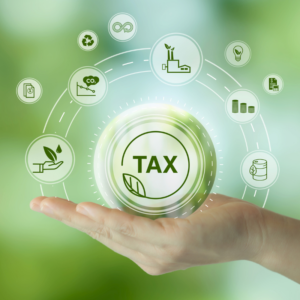Clean energy tax credits play a pivotal role in promoting sustainable development and combating climate change in our modern world. With increased need to transition to renewable energy sources, these tax incentives serve as powerful tools to incentivize clean energy adoption and investment. By offering financial benefits to individuals, businesses, and organizations that embrace environmentally friendly technologies, clean energy tax credits not only encourage a shift away from fossil fuels but also stimulate economic growth and job creation in the clean energy sector. Join Withum as we explore the significance of clean energy tax credits and their role in contributing to a cleaner, greener, and more sustainable future.
Additional Clean Energy Tax Credits for your Consideration
The advanced manufacturing production credit is a business credit for each eligible component (solar energy component, eligible wind energy component, eligible inverter, qualifying battery component, and applicable critical mineral) that is produced by the taxpayer in the United States or in a U.S. possession and is sold by the taxpayer to an unrelated person. For profit entities with no tax liability can have the credit be refundable for a five-year period.
With additional clean vehicle purchases, more infrastructure is needed. The maximum credit per charging station is generally 30% per the cost of the charging station, increased to $100,000 per station (not project). However, the charging stations must be placed in certain locations to be eligible for the credit. The Alternative Vehicle Refueling Property Credit is a federal tax credit designed to incentivize the adoption of eco-friendly refueling infrastructure.
Learn more about the Alternative Vehicle Refueling Property Credit.
The commercial clean vehicle credit provides a maximum federal income tax credit of $7,500 or $40,000 (if the gross vehicle weight is 14,000 pounds or above). Unlike the personal clean vehicle credit, there are no battery or critical mineral component requirements and final assembly does not have to occur in the United States.
Learn more about the Commercial Clean Vehicle Credit.
Under the Inflation Reduction Act, the energy credit starts at 6% and potentially can increase to 50%, for costs related to energy property placed in service before January 1, 2025. An alternative credit for clean energy projects is provided for property placed in service after December 31, 2024, with an additional requirement that the greenhouse gas emissions rate cannot be greater than zero.
Learn more about the Clean Energy Investment Tax Credit
Eligible contractors who construct energy efficient homes are provided a credit of up to $5,000 per dwelling unit sold or leased. The requirement that the building cannot exceed three stories is no longer applicable. In addition, the credit no longer impacts the basis utilized for the low-income housing tax credit.
As the world shifts towards a greener future, this federal tax credit encourages the adoption of electric vehicles (EVs), plug-in hybrid electric vehicles (PHEVs), and other qualified clean fuel vehicles. By taking advantage of this credit, you not only contribute to reducing greenhouse gas emissions but also experience significant savings on your tax liability. Get ready to explore the benefits of the Federal Clean Vehicle Credit and pave the way towards a cleaner and more sustainable transportation landscape.
Learn more about the Personal Clean Vehicle Credit.
Taxpayers are allowed a credit for up to 10 years for producing and selling renewable electricity. Renewable electricity is produced by a taxpayer from qualified energy resources at a qualified facility during the credit period and sold.
How to Monetize Clean Energy Credits
One of the most significant changes in the Inflation Reduction Act (“IRA”) is the ability for not-for-profits and for-profit companies to convert their clean energy credits to cash.
For-profit entities can apply clean energy credits against their federal income tax due. If no federal income tax is due, most clean energy credits can be carried back three taxable years or forward 22 years. However, for-profit entities that would like to monetize a credit quickly can conduct a one-time transfer (i.e., sale) of select clean energy credits to an unrelated party for cash under Internal Revenue Code §6418. Such a transfer does not create gross income for the taxpayer selling the credit or a deduction for the taxpayer purchasing the credit. To learn more, click here. In addition, for-profits can elect to have a credit be refundable when no federal income tax is due for certain designated credits, including the production of clean hydrogen, carbon oxide sequestration, and advanced manufacturing production credit.
While in previous taxable years, not-for-profits were limited to capturing the cash benefits related to clean energy credits directly unless they had unrelated business income tax, under the IRA, all not-for-profits are incentivized to invest in clean energy infrastructure through the direct payment program regardless of tax liability. The newly created direct payment option under Internal Revenue Code §6417 generally allows tax-exempt entities and State or political subdivisions to receive a cash tax refund for applicable credits.
The proposed regulations required electronic pre-filing registration for eligible taxpayers wanting to transfer clean energy credits or enter the direct pay program. This will include providing taxpayer identification and information regarding each eligible project/property that will contribute to the credit. The IRS will provide a registration number for each applicable credit property upon completion. The registration number must be provided on the tax return filed in the year the credit is utilized or transferred. The online pre-filing registration process is expected to launch in late 2023.
Below is a listing of tax credits and whether taxpayers can make a direct pay election or transfer the credit.
| TAX CREDIT | DIRECT PAY | TRANSFERABILITY |
|---|---|---|
| Alternative Vehicle Refueling Property Credit | Yes | Yes |
| Commercial Clean Vehicle Credit | Yes | No |
| Clean Energy Investment Tax Credit | Yes | Yes |
| Production Tax Credit | Yes | Yes |
| Advanced Manufacturing Production Credit | Yes | Yes |
Contact Us
For more information or to discuss your business needs, please connect with a member of our team.
Leadership
Featured Insights

Year-End Tax Strategies for Businesses
Now is the time to review and consider all of your year-end tax business planning options and strategies for the 2024 tax season. Check it out now.

Tax Update for Manufacturers: Clean Energy Tax Credits
The Inflation Reduction Act of 2022 has granted manufacturing, distribution and logistics companies new credit opportunities for maximizing the utilization of clean energy. Let’s discuss the extension and modification of […]

U.S. CleanTech Subsidiary Expansion 101
As the world increasingly prioritizes sustainable and environmental practices, CleanTech companies play a pivotal role in shaping a greener future. If you’re a CleanTech entrepreneur looking to expand your business […]

